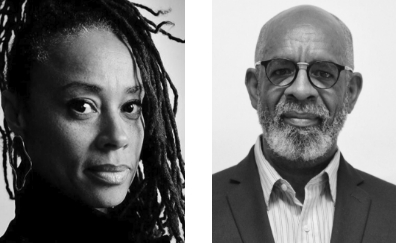Where it all began…
In 2018 the then Prime Minister asked Baroness Floella Benjamin to chair the Windrush Commemoration Committee, tasked with creating a permanent and fitting tribute to the Windrush Generation and their descendants. The windrush commemoration Committee is made up of influential black voices from the UK and many have a direct, personal connection to the Windrush Generation.
Waterloo Station
The Monument’s location, London Waterloo station, is significant to the Windrush story because thousands of Caribbean people arrived there from Southampton before dispersing across Britain. Today, millions of passengers and visitors pass through Waterloo station every year. When they see the Monument, they will be reminded of the incredible impact the Windrush Generation has had on the UK and our British history.
“I remember vividly my own moment of arrival, as a 10 year old – stepping off the train and standing on Platform 19 at Waterloo station. That spot, familiar to so many of us and our parents, is less than a few hundred metres from where the Windrush Monument will stand in perpetuity.”
– Baroness Floella Benjamin DBE
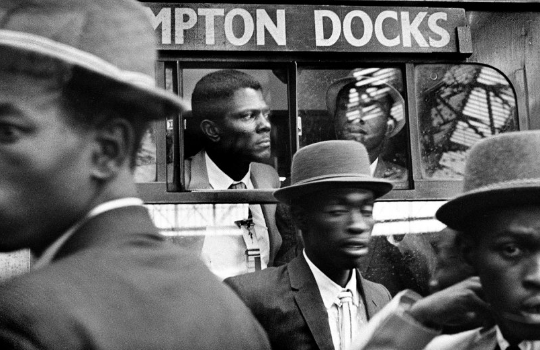
The search for an artist
The process for selecting an artist began in January 2021. Public art consultancy UP Projects, was appointed to manage the selection process, due to their track record of producing and curating contemporary art for public spaces and their experience in community engagement. Between January and February 2021, over 250 British and international cultural leaders, curators and leaders in the Caribbean community were invited to nominate artists in response to clear criteria for the commission, agreed by the Windrush Commemoration Committee (WCC). Over 100 artists were nominated, and then assessed against the criteria, from which 24 artists were invited to confirm their interest in the commission brief. Of the 24 artists who were approached, 16 artists submitted formal Expressions of Interest. This longlist comprised diverse artists, working across a range of media. All 16 were of Caribbean heritage and many with direct lived experience of the Windrush legacy, encompassing international and British artists from Chicago, Philadelphia, New York, Copenhagen, Trinidad & Tobago, Jamaica, Glasgow, Bristol, Birmingham and London. Artists at different stages of their careers were included, ranging from world renowned, highly established artists, and those who were less established but with a minimum five-year track record.
The WCC then assessed the longlist against the agreed criteria and shortlisted four artists to be taken forward to the proposal development and public engagement stage. The four shortlisted artists were Jeanette Ehlers, Valda Jackson, Thomas J Price and Basil Watson.
Each shortlisted artist presented their proposal via a short film. The films were shared nationally and internationally, with particular focus on reaching people with a British Caribbean background. From 14th July to 25th August 2021, the public was encouraged to consider the proposals and provide feedback through an online questionnaire as well as through five intergenerational focus groups of British Caribbean people. The WCC then assessed each proposal against the commission criteria through detailed discussion with the artists, consideration of feasibility reports and consideration of the public feedback. Basil Watson’s proposal received the highest score and he was awarded the commission in September 2021.
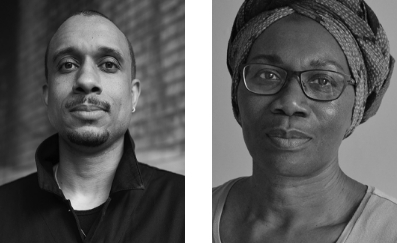
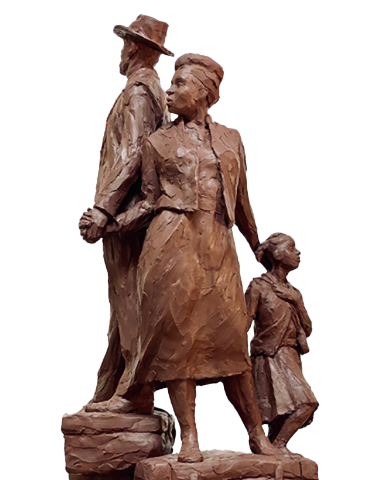
Here is what some members of our focus groups said about Basil’s design
“The family and the suitcases represent a beautiful mix of vulnerability and strength”.
“Now this is Windrush. This is perfect for Windrush”.
“The family all clutching onto each other is very touching…it’s them against the world”.
Basil Watson
Based between Jamaica and Atlanta, USA, Jamaican artist Basil Watson is a prolific sculptor and painter who has created a number of high-profile public monuments in the Caribbean and the USA. In 2016, the Government of Jamaica awarded Basil the Order of Distinction (Commander) in recognition of his artistic accomplishments. Since achieving international recognition, he has completed major commissions in China, Guatemala, and in various States within the US. He is known for his statues of sporting heroes such as Usain Bolt and Merlene Ottey, and most recently he was commissioned to create a 12-foot-tall statue of Martin Luther King Jr for the City of Atlanta, USA.
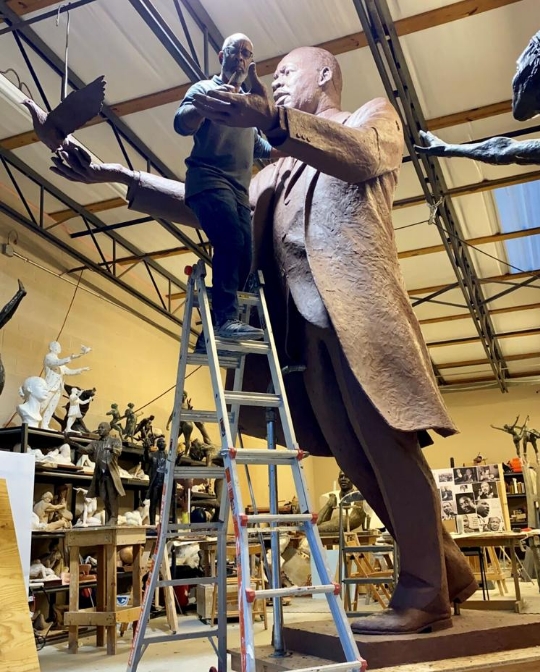
Basil Watson commissioned to create a 12-foot-tall statue of Martin Luther King Jr for the City of Atlanta, USA.
Here is what Basil had to say about the Commission and his design
This is a deeply personal project for Basil.
“I feel privileged that I now have this opportunity to express the aspirations, vision and courage of my parents, who took the long sea voyage to England in 1952 as part of that Windrush generation in search of a brighter future.”
Each part of his design has been carefully considered to reflect the experience of individuals, like his parents, who took this difficult journey.
The Suitcases
The suitcases are a symbol of significance and pride within Caribbean folklore. These suitcases are packed full of their belongings, representing their pride, dignity and values.
This type of suitcase, secured with latches and hinges, and reinforced with caps at the corners, gained cultural recognition thanks to the Jamaican radio drama “Dulcimina” of the 1960s -1980s in which the lead character’s suitcase came to be known as “Dulcimina’s Grip”. It contained everything that Dulcimina possessed from her humble rural background, and everything that she thought she needed in her new life.
The base of the monument is made up of seven suitcases, piled on the floor as they might have been upon arrival. They are bulging, battered and bruised, but they provide the foundation that the family needs to forge ahead.
The number seven is of great significance, referencing God’s creation of all things within seven days in Christian faith. The number is also considered to have spiritual importance in Hinduism, Islam and Judaism. Hence in the composition there is a suitcase for every day of the week and a metaphor for solution for every eventuality that they may face.
Their Clothing
They are wearing their “Sunday best”; jacket, tie and hat for the male; jacket and pill box hat for the female; pleated skirt, little handbag and plaited hair for the girl. Attention to clothing was customary in that era, especially in the Caribbean where immaculate attire was expected for special occasions. Their arrival in the “homeland” was certainly a special occasion.
Elements of the figures and their attire are inspired by photographs taken by Howard Grey at Waterloo Station in 1962.
The Figures
The three figures; man, woman and child are atop the mountain of suitcases.
The dynamic woman, mother and wife, is the central figure in the composition. She is strong, hand in hand with the male, eyes fixed ahead as she supports and encourages the apprehensive but expectant child.
The prideful male looks out with optimism, reflecting hope and dignity, assured in his stance and determined to progress.
Hands
The figures holding hands illustrates the strength of family, the importance of their inseparable bond and the aspiration of generational progress.
The hands are very important to the composition; they highlight the anxiety, tension, togetherness and compassion within the family.
After the initial model was created in Atlanta, the monument was sculpted and cast in bronze at Pangolin Editions sculpture foundry in Stroud, Gloucestershire. Their brilliant team supported Basil to create the monument you see today at incredible speed.



Graphic Design
The dedication text that accompanies the Monument at Waterloo Station was designed by Abi Wright, British graphic designer of Caribbean heritage. For the title graphics, Abi has used a sans serif font designed by black British graphic designer Greg Bunbury called Empire Windrush, a typeface inspired by the iconic lettering on the HMT Empire Windrush passenger ship, paying tribute to the Windrush arrivals through a typeface that is as unique as the passengers who stepped off the boat over 70 years ago.

THE WINDRUSH COMMEMORATION COMMITTEE
With thanks to the Windrush Commemoration Committee who pioneered this project.
Baroness Floella Benjamin DBE, DL, Chair
Paulette Simpson CBE, Deputy Chair
Sir Ken Olisa OBE, CStJ, FRSA, FBCS
The Bishop of Dover, The Rt Revd Rose Hudson-Wilkin CD, MBE
Ansel Wong CBE
Professor Geoff Thompson MBE, FRSA, DL
Tim Campbell MBE
Simon Frederick
Co-opted members:
Philomena Davidson PPRSS
Professor Steve Eichhorn
Keith Taylor JP
Please click the button below to see the Windrush Monument Unveiling Programme (22nd June 2022)
Partners
Thank you to the incredible partners who worked tirelessly to make this project a success.
Up Projects

Ramboll

Pangolin Editions

Dac Beachcroft

Juicy Media

APS Group

Live Group

Network Rail

Abi Wright, Graphic Design

Funding and donation
The National Windrush Monument has been funded by the Department for Levelling Up, Housing and Communities.

The site was generously donated by Network Rail

